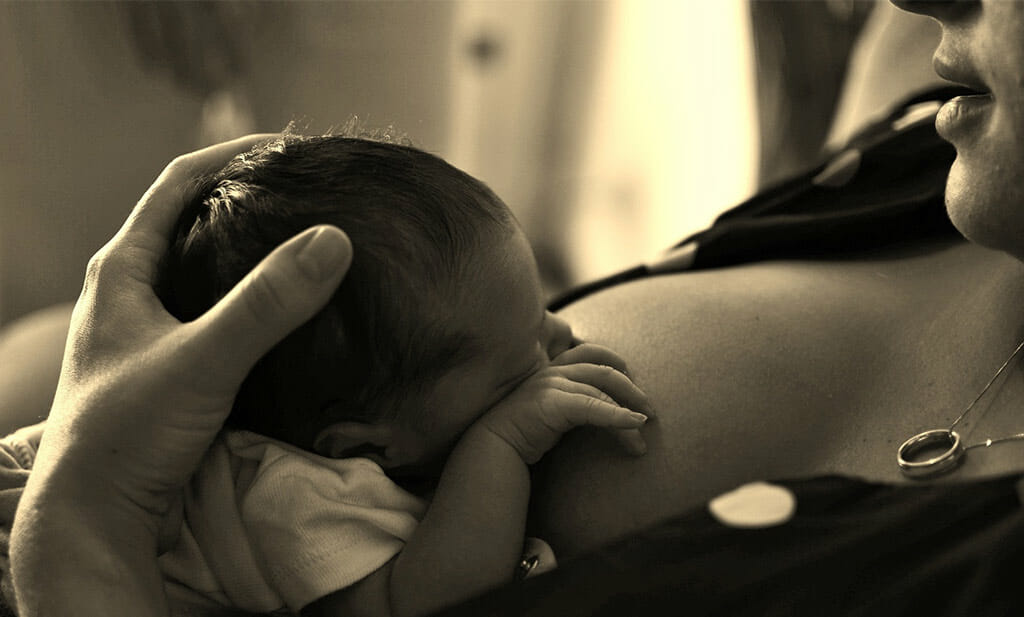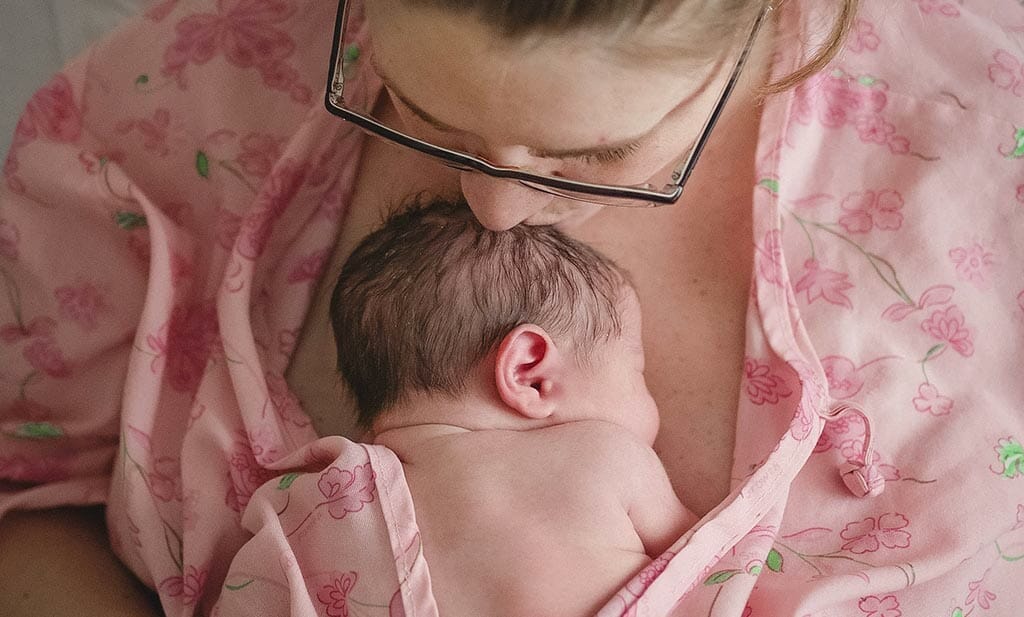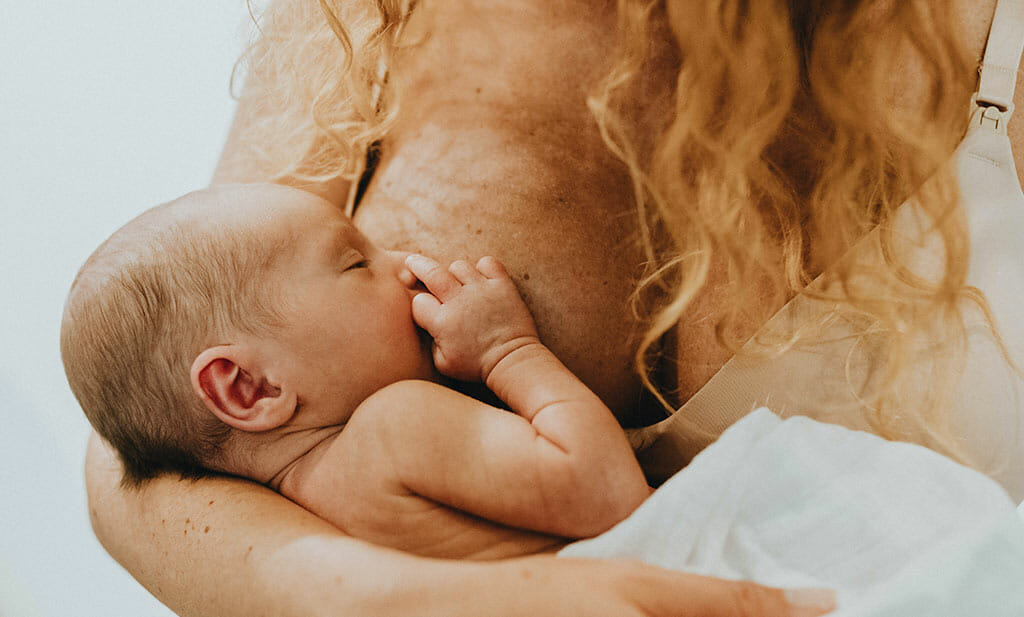
Are you expecting a baby and want to breastfeed no matter what? Then this is the right article for you. Because many chest/breastfeeding problems in the early postpartum period can be avoided if you keep a few important things in mind. Since the first hour after birth is the most important foundation stone for a successful chest/breastfeeding start, today we would like to take a closer look at the nine phases of a newborn’s adjustment. Our midwife and babywearing expert Katrin Ritter will again explain to you what you and the midwives looking after you should pay attention to.
The nine phases of a newborn’s adjustment
The Swedish doctor Prof. Dr. Ann-Marie Widström from the Karolinska Institute in Stockholm and her team observed children in the first hours after birth and analysed hundreds of hours of video material. They discovered nine phases of postnatal adaptation in direct skin-to-skin contact.
Basically, direct skin-to-skin contact means many advantages for mother and child:
Child can follow its natural reflexes and latch on = chest/breastfeeding initiation
Stabilisation of all bodily functions
Avoidance of adjustment disorders
Chest/Breastfeeding of basic needs
Promotion of bonding, basis for a secure attachment
Promoting self-regulation and calming
Reduction of stress and pain
Promoting early coordination of the child’s five senses (sight, hearing, taste, smell, touch).
Widström emphasises that it is important for the child to go through these nine stages of adaptation at his or her own pace. This assumes, of course, that the child is fit and healthy and that no further intervention is necessary.

The 9 phases – guided by the newborn
Phase 1: Birth cry
The first phase is characterised by the initial birth cry. The child breathes independently for the first time and clears the airways of amniotic fluid. It shows reflexes such as the Moro reflex. The arms are jerked out to the side and the fingers are spread. The baby should now be quickly dried and placed lengthwise on the mother. The baby’s head should lie between your breasts.
Phase 2: Relaxation
This is a silent and motionless where the baby hears the mother’s heartbeat and just relaxes, while keeping warm.
Phase 3: Awakening
The baby starts to move and makes small mouth movements. The eyes open and focus a short time later.
Phase 4: Activity
The baby now moves more purposefully, possibly turns its head and does tongue exercises. The newborn recognises the smell of the mother’s chest/breast from the amniotic fluid and touches the breast with the hand, transferring this taste to the mouth. There should be no external intervention here. The baby recognises the mother’s nipple and voice and seeks eye contact about 30 minutes after birth – an unforgettable moment.
Phase 5: Rest
The baby rests, eyes open or closed. It can also suck its fingers. It is important to respect this rest and not to intervene. Otherwise the baby will have to start again with phase 1 and the probability increases that it will not get to phase 8 for sucking before it falls asleep.
Phase 6: Robbing
With crawling movements, the baby can move between the mother’s chest/breasts to the nipples. The reflexive kicking of the feet also stimulates the uterus. The baby can be supported with a hand under the foot or the mother can be positioned so that the nipple is easily accessible.
Phase 7: Familiarisation
The baby makes pleading calls as soon as it reaches the nipple. It familiarises itself with the chest/breast by licking the nipple and areola and shapes them. It massages the chest/breast to encourage oxytocin release in the mother. This takes about 20 minutes or more and is crucial for chest/breastfeeding success. Often the baby will suckle once or twice and then let go of the chest/breast. This is normal and should not be interpreted as inability.

Stage 8: Sucking
The newborn docks at the nipple and feeds. The hands stop moving, the eyes focus. When the baby docks at the breast itself, this is a perfect first chest/breastfeeding, even if it changes its posture once again. The newborn does not need any help for this.
Phase 9: Sleep
After about one and a half hours, the baby falls asleep for the first time and needs to relax.
The best basis for a good start to breastfeeding is therefore immediate, undisturbed and extended skin contact immediately after birth (at least one and a half hours without interruption). Only after the sleeping phase should the baby be looked at, washed and changed. Afterwards, if possible, go directly back to being naked on the mother’s chest/breast. In the next few weeks, frequent skin contact has a supportive effect – ideally for at least three hours throughout the day. These physiological phases of adjustment are elementarily important for a good start in life and a successful beginning of breastfeeding. So wherever you give birth, it is advisable to talk to the staff and try to make this important adjustment possible for your baby.
And a note to anyone who has already had a baby who did not have the opportunity to go through these nine stages independently: In many cases, mother and baby do not get this space. Why? Simply because many midwives did not learn these stages as part of their training, because time is often short or there were complications at birth. And yet we have many successful chest/breastfeeding mamas and happy children in this world. Your love and closeness are crucial – and beyond the first hours.
In the next part of our chest/breastfeeding series, we will look at the most common chest/breastfeeding problems in the early postpartum period and how good chest/breastfeeding works.
————————————————————————–
Source: Deutsche Hebammen Zeitschrift, Haut an Haut, Widström et al., Issue 10-2019



